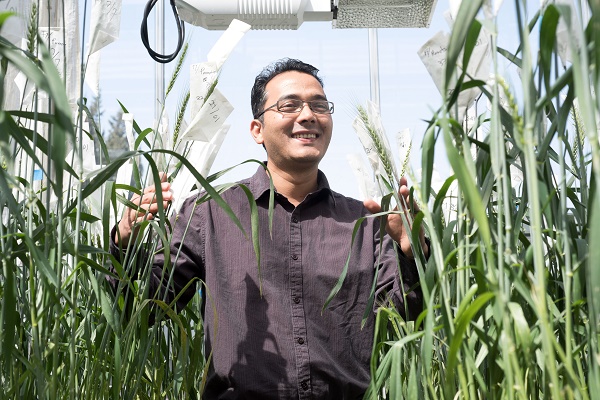
Breaking Ground is a regular series featuring staff at CIMMYT
MEXICO CITY (CIMMYT) – Scientist Bhoja Raj Basnet knows first hand what it is like to be a smallholder farmer.
Basnet’s earliest memories were formed on a one-acre subsistence farm in Jhapa, in southeastern Nepal, a fertile area in a country where the livelihoods of nearly 65 percent of people depend on agriculture.
The tiny farm provided the foundation for a journey that led ultimately to a doctoral degree in the United States and a career as a wheat breeder in Mexico at the International Maize and Wheat Improvement Center (CIMMYT).
Wheat plays a major role in Nepal’s agricultural landscape. It is the country’s third largest crop, cultivated on about 750,000 hectares of arable land each year with an average yield of 2.5 tons per hectare. Above wheat, farmers favor only rice and maize.
“I grew up playing with the plants and soil on my family’s farm and before I entered high school I knew I wanted to pursue a career in agricultural science.” Basnet explained. “As I got older I started to realize the importance of agriculture and how agriculture can really shape a child’s health and future. This is what really pushed me to pursue my career.”
Basnet went on to earn his master and doctoral degrees in plant breeding. After graduation in 2012 from Texas A&M University, Basnet joined CIMMYT as a postdoctoral fellow working in the bread wheat improvement program.
In 2014, Basnet began leading a project conducting research into hybrid wheat in collaboration with Syngenta, which involves researching and developing tools and technology for developing commercially viable hybrid CIMMYT wheat varieties.
Hybrid wheat is created when a breeder intentionally crosses two genetically distinct and stable wheat lines to produce an offspring that combines the best traits of the parents. The process of developing a hybrid can take years, as traits are carefully chosen to achieve desired characteristics, such as increased grain yield or stress tolerance.
The principle behind hybrid varieties is exploitation of heterosis, the superiority of the hybrid offspring over its parent varieties. This is a biological phenomenon observed in almost all living organisms. However, the magnitude of “heterosis” varies significantly based on several biological and environmental factors.
“Hybrid wheat has always fascinated me,” Basnet said, adding, “I really want to see the end results and to see this work succeed.”
Hybrid wheat varieties have proven to be tricky. In fact, CIMMYT’s first attempt to develop hybrid wheat occurred in the 1960s and despite stops and starts over the years, has been ongoing since 2010.
Increasing investment and long-term funding commitments are a key prerequisite to achieving success in crop improvement, especially in breeding, Basnet said. Unlike traditional wheat variety development, successful research into hybrid wheat varieties depends largely on the willingness and active engagement of private sectors into research and seed businesses.
Basnet is working to develop a hybrid wheat foundation at CIMMYT by using new technology and existing research on hybrids. This hybrid wheat foundation will create genetic diversity within wheat to increase genetic gains and develop tools that can produce large amounts of hybrid seed.
“Currently less than one percent of wheat crops globally are hybrid wheat,” Basnet explained. “We need to continue with this research, as hybrid crops could lead to 15 to 20 percent greater yield potential and in particular higher stability, a very important trait with climate change.”
 Innovations
Innovations 
